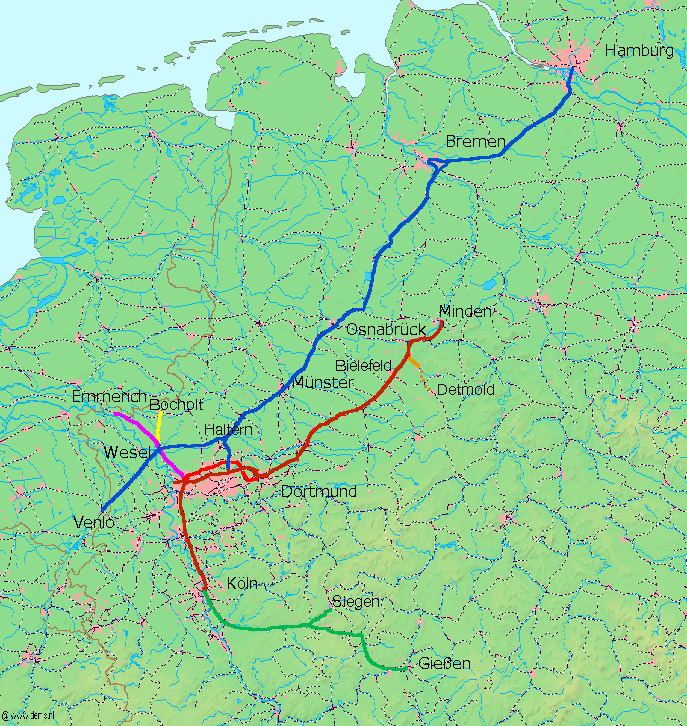Line length 56 km (35 mi) Line number 2650 | ||
 | ||
Track gauge 1,435 mm (4 ft 8 ⁄2 in) standard gauge Operating speed Route number 416 (Long distance)450.2 (S-Bahn) 119.5 Dortmund Hbfterminus S 1S 2S 5 | ||
The Duisburg-Dortmund Railway is an important and historically significant railway in Germany. It is a major axis for long distance and regional passenger freight transport in the northern Ruhr. It is served by Intercity-Express, InterCity, Regional-Express, Regionalbahn and S-Bahn trains. It includes the central stations of Duisburg, Oberhausen, Gelsenkirchen, Dortmund and Wanne-Eickel and the regionally important stations of Essen-Altenessen and Herne. It is the middle section of the Cologne-Minden trunk line from Cologne-Deutz to Minden. It was opened in 1847 and has been modernised and developed several times since then. Today, it has two to four tracks and is electrified and classified as a main line.
Contents
History
On 18 December 1843, the Prussian government granted a concession to the trunk line to the Cologne-Minden Railway Company (German, old spelling: Cöln-Mindener Eisenbahn-Gesellschaft, CME) for the line, which began at what was then the CME station in Deutz (now a suburb of Cologne) with the construction of the first section to Düsseldorf, which was opened on 20 December 1845. Only a few weeks later, on 9 February 1846, the second section was completed to a temporary terminus at the site of present-day Duisburg Hauptbahnhof called the Cologne-Minden railway station, the first of three train stations built at the same place.
The route of the next section to Oberhausen, Altenessen, Gelsenkirchen, Wanne, Herne and Dortmund to Hamm was chosen over a route close to the coal mines that were then located on the north bank of the Ruhr because it was cheaper to build as it largely avoided hills. Nevertheless, it still took well over a year until 15 May 1847 for this section to be completed and put into operation. On 15 October 1847 the last section was opened to Minden, thus completing the entire 263 kilometre long, single track railway. On the same day the Royal Hanoverian State Railways opened its Hanover-Minden Railway, completing a connection to Berlin and northeastern Germany.
Branch line to Duisburg-Ruhrort
In 1848 the CME built a branch line to the docks at Ruhrort from Oberhausen station and agreed with the Aachen-Düsseldorf-Ruhrort Railway Company (Aachen-Düsseldorf-Ruhrorter Eisenbahn-Gesellschaft) to construct the Ruhrort-Homberg train ferry.
Holland line
The Oberhausen Station was also at the beginning of a line opened on 20 October 1856 to Arnhem via Wesel and Emmerich am Rhein, popularly known as the Holland line.
Rollbahn
Wanne station (now Wanne-Eickel Hbf) was from 1 January 1870, the starting point for a line to Hamburg called the Rollbahn (Rolling Line). This line along the German North Sea coast was part of the Paris-Hamburg Railway, linking with the CME’s concession from the Prussian government for a Hamburg-Venlo railway.
Emscher Valley Railway
From 1871 to 1878 the CME built another line from Duisburg to Dortmund along the Emscher valley largely parallel to its trunk line via Osterfeld Süd and Wanne through the northern Ruhr to service the growing industries and prosperous coal mines.
Current situation
Since the railway line was opened from Duisburg to Dortmund it has grown in importance as the centre of coal mining in the Ruhr has migrated north and it has continually been modernized. Today the line is at least double track and electrified for its entire length. The route is now comparable to the other east-west line, in particular the central Ruhr trunk line of the former Bergisch-Märkische Railway Company.
Services
Long distance trains only use parts of the line. The section from Duisburg to Oberhausen is served by Intercity-Express trains to and from Amsterdam. It is also served by Regional-Express trains on line RE 5 Rhein-Express, terminating in Emmerich and the Regionalbahn lines RB 35 (to Emmerich am Rhein) and RB 33 Rhein-Niers-Bahn (to Wesel). Every two hours InterCity line 35 uses a large part of the line from Duisburg to Wanne-Eickel. In addition occasional trains of IC lines 26 and 32, and RE 2 Rhein-Haard-Express and RB 42 and RB 46 Glückauf-Bahn regional trains use the section form Gelsenkirchen to Wanne-Eickel Hbf.
The only Regional-Express that uses the total length of the route is RE 3 Rhein-Emscher Express, which runs from Düsseldorf to Hamm, all on the route of the trunk line of the Cologne-Minden Railway Company.
S-Bahn line S 2 runs at 20-minute intervals between Herne and Dortmund Mengede and continues to Dortmund via the Southern route of the former Royal Westphalian Railway Company (Königlich-Westfälische Eisenbahn-Gesellschaft). West of Herne, one train per hour connects to or from Recklinghausen and one connects Gelsenkirchen with Essen. Therefore, only one out of three trains per hour operates along the entire historic route between Duisburg and Dortmund.
